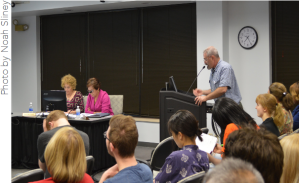By: Christina Perkins
Staff Writer
A new evaluation system has been created for STLCC faculty. Launched this fall semester, the new system is designed to create more accurate evaluations and allow for growth of full-time faculty.
Vice Chancellor Andrew Langrehr and Forest Park Librarian Jeffrey Papier both spoke at a board meeting Oct. 19 about the new system. Langrehr explained that the old system had been in place since 1981 and was overdue for an update. The timing for the update is no coincidence; the Higher Learning Commission will be visiting STLCC this February for evaluation purposes.
“The charge for this group was to create a new faculty evaluation system for full-time faculty at St. Louis Community College. To do that, we needed to do a lot of research and the best practice in the literature and take a look at other colleges in this lane. We did some surveying of our faculty to determine what issues they saw,” says Langrehr.
Previously faculty were required to be evaluated once every three years. Faculty had to pass out student surveys in just one of their classes, were visited by the chair and dean of their subject and had to put together a portfolio packet displaying new class materials. According to Papier, the old system wasn’t helping faculty grow. “The new system is designed with professional growth and improvement for faculty in mind. [It] focuses on empowering and improving faculty to enhance and expand their professionalism, especially in the areas of growth through teaching and growth through service through the college,” said Papier.
With the new system, faculty receive student feedback each semester and also throughout their three year cycle rather than at the last year of the cycle. There are also new components of the student faculty evaluation. Faculty must receive at least one student evaluation per semester and there must be two in-class evaluation per cycle, performed by the dean of their respective department and a faculty member of choice.
Doug Hurst, Meramec communications professor, said the old system was limited in how it could help teachers improve. Hurst was part of the task force to help create the new evaluation system.
“I’m excited about it. We’ve been working on it for about a year and a half,” said Hurst. “[The new system] focuses on professional development, teaching and learning about our growth as faculty opposed to being strictly summative as the last system. ”
According to Langrehr, the task force, established in May 2016, consisted of 15 members that represented the district, including faculty from various disciplines and HR, the deans and Langrehr himself.
Hurst said he believes the new system is a big improvement over the old one. “I think the [it’s] better for staff and faculty. This system helps teachers be better teachers and more effective in the classroom and helping students,” said Hurst.











